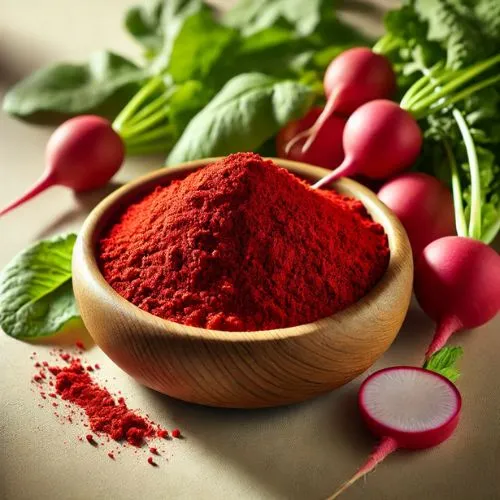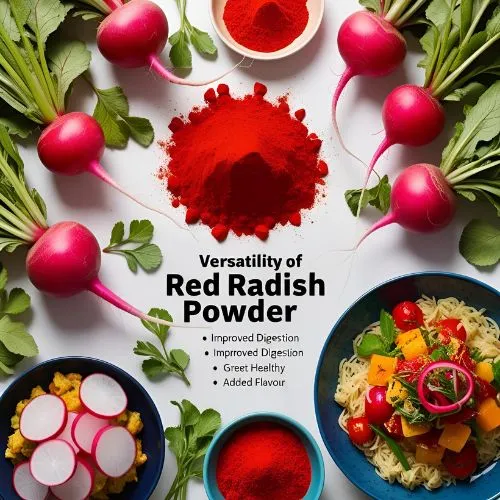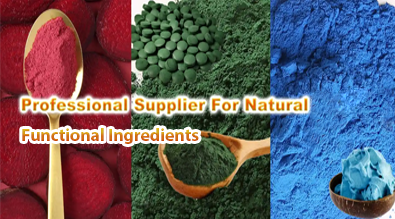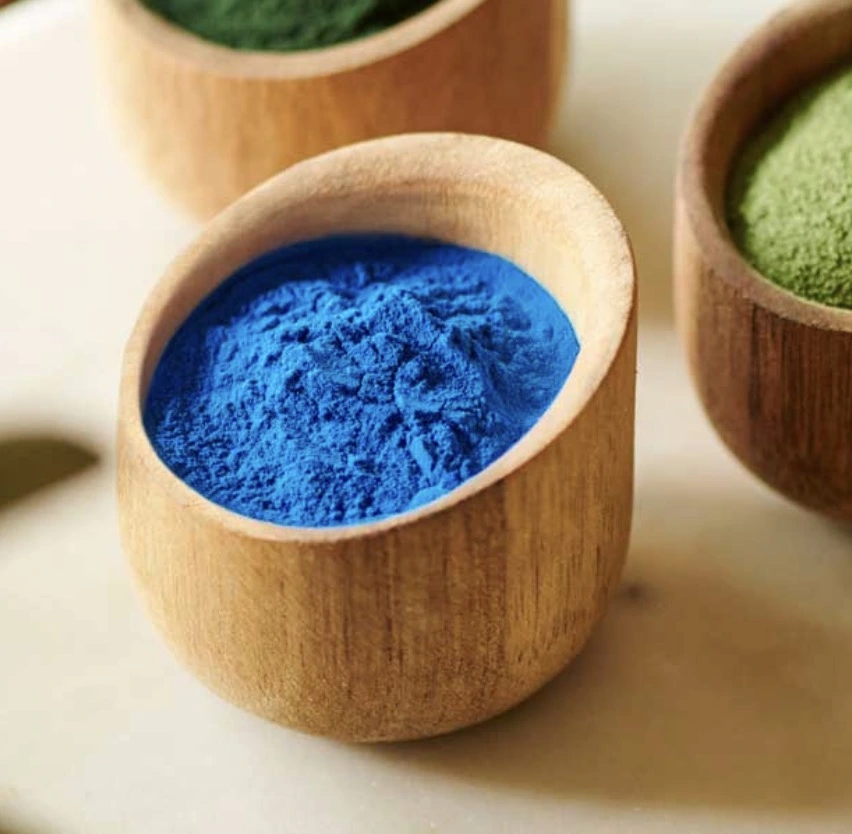How Red Radish Powder E163(i) Enhances Food Appearance?
In the ever-evolving world of food innovation, natural colorants have gained immense popularity. Among these, Red Radish Powder E163(i) stands out as a versatile and vibrant option for enhancing food appearance. This blog post delves into the reasons behind its rising popularity, its numerous benefits, and practical ways to incorporate it into your culinary creations.

Why Red Radish Powder is a Popular Natural Colorant?
Red Radish Powder E163(i), derived from the tuberous roots of radishes, has become a preferred choice for food manufacturers and chefs alike. Its popularity stems from several key factors:
- Natural Origin: With the growing demand for clean-label products, Red Radish Powder stands out as a natural alternative to synthetic colorants, making it an appealing choice for consumers seeking healthier, more transparent ingredients.
- Vibrant Hue: The powder provides a striking red color, with shades ranging from orange-red to purple-red, depending on the pH level of the food it is incorporated into. This natural vibrancy enhances the visual appeal of a variety of food items.
- Stability: Red Radish Powder E163(i) offers excellent stability, particularly in acidic environments, setting it apart from other natural colorants that may fade or change under similar conditions. This makes it a reliable choice for long-lasting color retention.
- Versatility: Due to its water solubility, Red Radish Powder is highly versatile and can be easily incorporated into a wide range of food and beverage applications, from beverages to dairy products and beyond.
- Clean Taste Profile: The powder has a subtle flavor profile, ensuring that it doesn’t overpower the natural taste of the food. This allows the authentic flavors of the product to remain the focal point.
The unique anthocyanins present in Red Radish Powder contribute to its distinct coloration. These pigments not only provide aesthetic appeal but also possess potential health benefits, aligning with the growing consumer interest in functional foods.

Top Benefits of Using Red Radish Powder in Foods
Incorporating Red Radish Powder E163(i) into food formulations offers a multitude of advantages:
- Enhanced Visual Appeal: The vivid red hue can transform the appearance of various foods, making them more appetizing and Instagram-worthy.
- pH-Responsive Color Changes: The powder's ability to shift color based on pH levels adds an element of intrigue and can be leveraged for innovative product development.
- Clean Label Solution: As a natural ingredient, it aligns with clean label trends and can replace artificial colorants in many applications.
- Potential Antioxidant Properties: The anthocyanins in Red Radish Powder may offer antioxidant benefits, although more research is needed to fully understand their impact in food matrices.
- Thermal Stability: Unlike some natural colorants that degrade with heat, Red Radish Powder maintains its vibrancy even in high-temperature processing.
- Regulatory Compliance: As E163(i), it's approved for use in various regions, simplifying regulatory hurdles for food manufacturers.
The multifaceted benefits of Red Radish Powder make it an invaluable tool in the food industry's quest for natural, visually appealing, and potentially healthier products.
How to Incorporate Red Radish Powder for Stunning Dishes?
Red Radish Powder E163(i) offers culinary professionals and home cooks alike a palette of possibilities. Here are some creative ways to leverage its color-enhancing properties:
- Baked Goods: Incorporate the powder into cake batters, cookie doughs, or bread recipes for a natural pink or red hue. It's particularly effective in creating vibrant red velvet cakes without artificial colors.
- Beverages: Add a pinch to smoothies, lemonades, or cocktails for a striking ruby tint. The powder's water solubility ensures smooth integration.
- Dairy Products: Blend into yogurts, ice creams, or cheese spreads to create visually appealing pink or red varieties.
- Confectionery: Use in candies, chocolates, or marshmallows for natural red or pink coloration. It's especially useful in creating Valentine's Day themed treats.
- Savory Applications: Enhance the color of tomato-based sauces, soups, or even plant-based meat alternatives for a more appetizing appearance.
- Decorative Elements: Mix with icing sugar to create vibrant cake decorations or use to dust plates for an artistic touch in plating.
When working with Red Radish Powder, it's crucial to consider the pH of your food matrix, as this will influence the final color. Experimentation is key to achieving the desired hue and intensity. Additionally, the powder's concentration can be adjusted to achieve varying shades, from subtle pink to deep red. Start with small amounts and gradually increase until the desired color is achieved.
For the best results, it’s recommended to dissolve the powder in a small amount of water or another liquid ingredient from your recipe before adding it to the main mixture. This step helps ensure even distribution of the powder throughout, preventing clumping and promoting a smooth blend. By dissolving it first, you’ll achieve a more uniform texture and enhance the overall consistency of your dish or formulation.

Conclusion
In conclusion, Red Radish Powder E163(i) offers a natural, versatile, and visually stunning solution for enhancing food appearance. Its ability to create vibrant hues while aligning with clean label trends makes it an indispensable tool in modern food formulation. As consumers continue to seek out natural and visually appealing food options, Red Radish Powder is poised to play an increasingly significant role in the food industry.
For more information on Red Radish Powder E163(i) and other natural plant extracts, please contact us at info@yanggebiotech.com. Our team of experts is ready to assist you in creating innovative, high-quality products that meet the evolving demands of today's market.
References
1. Smith, J. (2022). Natural Food Colorants: Trends and Applications in the Food Industry. Journal of Food Science and Technology, 45(3), 267-280.
2. Johnson, A., & Brown, L. (2021). Anthocyanins from Red Radish: Extraction, Stability, and Potential Health Benefits. Nutrients, 13(8), 2745.
3. Lee, S., et al. (2023). pH-Responsive Color Changes of Natural Pigments in Food Systems. Food Chemistry, 410, 134621.
4. Garcia-Viguera, C., & Bridle, P. (1999). Influence of structure on colour stability of anthocyanins and flavylium salts with ascorbic acid. Food Chemistry, 64(1), 21-26.
5. Rodriguez-Saona, L. E., et al. (2001). Anthocyanin Pigment Composition of Red Radish Cultivars as Potential Food Colorants. Journal of Food Science, 66(3), 351-356.

Based on your location and order quantity, you will have the opportunity to receive a limited time free shipping promotion!

Who we are


